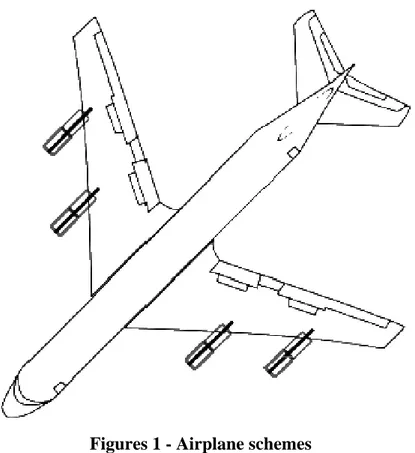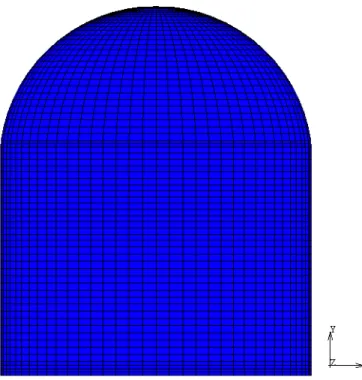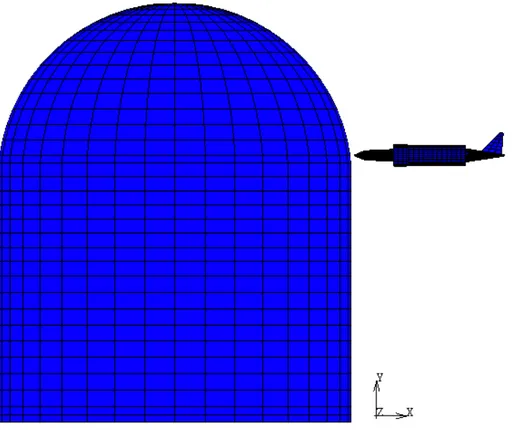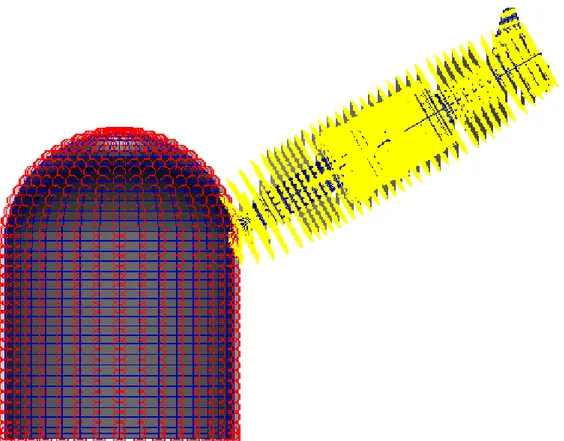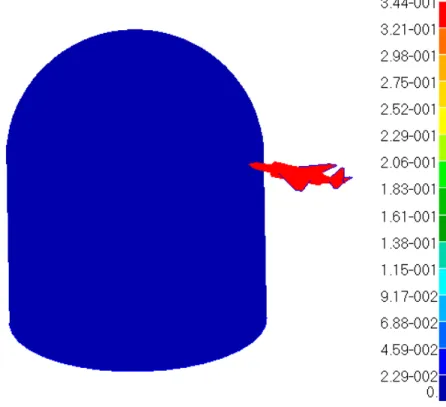Dynamic Global Structural Response of an Innovative
Reactor Subjected to a
n
A
i
rcraft Impact
Ente emittente CI RTEN
PAGINA DI G
UARDIA
Descrittori
Tipologia del documento: Collocazione contrattuale:
Rapporto Tecnico
Accordo di programma ENEA-MSE: tema di ricerca "Nuovo nucleare da fissione"
Reattori nucleari ad acqua, Reattori nucleari evolutivi Analisi Incidentali
Argomenti trattati:
Sommario
Questo rapporto è stato emesso nell'ambito del PAR 2008-2009 dell'accordo di programma ENEA-MSE e costituisce uno dei deliverable dell'obiettivo D "Analisi di sistema: Analisi eventi esterni" della linea progettuale LP2 "Reattori evolutivi" del tema di ricerca "Nuovo Nucleare da Fissione".
Lo studio di eventi esterni riportato nel documento è relativo all'impatto areo ed è focalizzato sull'analisi della risposta globale di una struttura di contenimento di un reattore SMR e sulla valutazione della vulnerabilità dei principali sistemi di sicurezza, strutture e componenti. A questo scopo è stato adottato un approccio deterministico per la corretta rappresentazione dell'interazione
struttura-struttura indotta dall'impatto dell' aereo. Le simulazioni effettuate che hanno considerato impatti orizzontali e inclinati, di aerei commerciali e militari sull'edificio di contenimento hanno mostrato la capacità degli isolatori di garantire l'integrità complessiva dell'impianto pur in presenza di danneggiamenti progressivi localizzati.
Note
Copia n. In carico a:
Consorzio Interuniversitario per la Ricerca TEcnologica Nucleare
Lavoro svolto in esecuzione della linea progettuale LP2 punto D2
UNIVERSITY OF PISA
Department of Mechanical Nuclear and Production Engineering
Dynamic global structural response of an innovative reactor
subjected to an aircraft impact
Authors
R. Lo Frano G. Forasassi
CERSE-UNIPI RL 1082/2011
Contents
LIST OF FIGURES _____________________________________________ 2
LIST OF TABLES ______________________________________________ 2
NOMENCLATURE _____________________________________________ 3
1. INTRODUCTION ____________________________________________ 4
2. AIRCRAFT IMPACT ASSESSMENT____________________________ 6
2.1 RCB Dynamic Response_______________________________________ 9
2.2 Aircraft Model______________________________________________ 10
3. NUMERICAL ANALYSIS _____________________________________ 12
4. MAIN AIRCRAFT CRASH ANALYSES RESULTS_______________ 17
5. CONCLUSION ______________________________________________ 25
REFERENCES ________________________________________________ 26
LIST OF FIGURES
Figures 1 - Airplane schemes... 8
Figure 2 – NPP outer containment model... 9
Figures 3 – View of the Phantom F4 (a) and Boeing 747 (b) FE models... 11
Figure 4 – View of the Phantom F4 impact direction ... 12
Figures 5 – View of Boeing 747 impact directions... 13
Figure 6 – Elastic-Plastic, Stress-Strain Curve ... 14
Figures 7 – Scheme of the Master – Slave contact ... 15
Figure 8 – Overview of the adaptive contact interface for a 30° inclined impact ... 16
Figure 9 – RCB penetration depth for Phantom F4 horizontal impact ... 17
Figure 10 – Stress behaviour in RCB wall close the impact entry: at the inner (a), outer (b) and middle (c) thickness ... 19
Figures 11 – Stress behaviour in RCB wall far away the inclined impact entry: at the inner (a), outer (b) and middle (c) thickness... 20
Figure 12 - Penetration analysis results: stress distribution for horizontal impact... 21
Figures 13 - Penetration analysis results: stress distribution for inclined impact ... 22
Figures 14 – Comparison between civilian and military aircraft impact stresses ... 23
LIST OF TABLES
Table 1 – Airplanes Data ... 8NOMENCLATURE
CFR Code Federal Regulations FEM Finite Element Method
IAEA International Atomic Energy Agency LWR Light Water Reactor
NPPs Nuclear Power Plants
RCB Reactor Containment Building SSCs Systems, Structures and Components
USNRC United States Nuclear Regulatory Commission VVER Water-Water Energetic Reactor
1. INTRODUCTION
Nuclear power plants are already recognised as being very robust structures and therefore more secure than many industrial facilities.
In general NPPs designers are confident of the safety of structures and systems that characterize the containment system, which has to be able to withstand dynamic loads, natural or malevolent events as flooding, earthquakes, hurricanes, aircraft impact, explosion etc., even though in the past they were not specifically designed for this type of loads.
The outer containment system, which is the last “defence” barrier against an uncontrolled release of radioactivity to the environment and population, is normally characterized by thick and heavy reinforced concrete walls capable to prevent and/or reduce the unbearable damages caused by an aircraft crash due to accidents or terrorism.
The aircraft impact accident has become very significant in the containment design after the tragic September 2001 event, also due to the raised public concern about the potential damaging effects that a large civilian airplane impact could bring in safety relevant structures. For this reason the aircraft impact analysis, although considered a “beyond-design-basis” condition, is become necessary to properly assess the general safety of a nuclear facility in many countries [1-2].
The first requirements concerning the aircraft crash were introduced for nuclear reactors and for nuclear fuel facilities (reprocessing plants, etc.) in 1979/80 by UK, France and USA, respectively assuming the aircraft crash as accidental event. Even if formerly the considered reference aircraft was a military one, at present, accordingly to the 10 CFR 50.150 [3], the impact of a large commercial aircraft using realistic analyses is required to adequately evaluate the impact effects on a nuclear plant containment (both in supporting the NPP licensing process and the so-called stress tests assessments).
Furthermore the plant response will be used to identify and incorporate into the design “those design features and functional capabilities to show that, with reduced use of operator actions: (i) The reactor core remains cooled, or the containment remains intact; and
(ii) Spent fuel cooling or spent fuel pool integrity is maintained”[3].
Therefore, as aforementioned, owing to the raised public concern for the potential dangerous effects of an aircraft crashing on critical structures of a nuclear facility, including power plants,
also the impact of a large commercial aircraft, used for long distance flights, must be investigated in the design process.
The impact of a military or civilian aircraft would not be expected to penetrate the reactor containment building, which, for instance, for large III or III+ LWRs is at present a double containment structure made of heavily steel reinforced concrete with thickness larger than one metre at least, such as Areva's EPR and the Russian VVER-1200 containment walls.
In this study the attention is focused on the understanding of the global response and the evaluation of the vulnerability of the main safety relevant systems, structures and components (SSCs) in the postulated event.
The main structural effects of the “structure-structure interaction”, related to bodies undergoing dynamic contact, and the failure mechanisms of the fast moving and deformable aircraft structure into rigid and/or deformable bodies, like a NPP outer containment building, were analyzed.
To this purpose accurate simulations of the contact behaviour at material interfaces, defined by means of “slave and master” segments approach were performed in order to provide realistic predictions of the crashing phenomenon.
Suitable contact algorithms were implemented, in a dynamic finite element code, assuming explicit large deformation to incorporate “master-slave sliding interfaces”. In general, a contact algorithm allows to automatically associate the structure deformation to the interface boundary conditions.
As a result of the impact, a finite amount of kinetic energy, which depends upon the inertial and stiffness properties of missile and target structure, is transferred from the “striking” aircraft to the impacted walls: the reactor containment building will deform elastically and beyond up to the point of permanent yielding, while some components of the aircraft sufficiently tough (assumed as rigid projectiles) will strike and eventually might begin to penetrate the building walls.
In addition it is important to note that a small kinetic energy contribution, which could be considered negligible, is also lost by friction and/or as well converted into the elastic vibration of the entire building.
2. AIRCRAFT IMPACT ASSESSMENT
With reference to the previous considerations, the problem of the reliability of a NPP is mainly related to the evaluation of the minimum wall thickness of the reactor containment building (RCB) necessary to ensure the overall plant safety and, in the same time, to prevent the local perforation, particularly in the case of a large aircraft crash.
Protection of a NPP against aircraft impacts relies upon strengthened reactor containment and other safety function buildings, together with wide application of the physical separation of the safety systems and the enclosing building structures. The considered impact process is obviously a definite interaction between a very large stationary building and a relatively small (in the sense of mass ratio with the building) but fast moving airplane, both of which undergo considerable deformations.
Studies on aircraft impact of nuclear facilities predates the event of September 11, 2001. Some of the researches focused on the analysis of the impacted structure response were performed adopting the load function approach (Riera 1968; Crutzen and Reyneu, 1983; Abbas et al., 1996, etc. [3-4-5]), while others addressed non-malevolent aircraft impact using probabilistic approaches (Chelapati et al., 1972); however a detailed reliability analysis for an aircraft crash is not common in the past literature.
Therefore, as already mentioned, a realistic impact analysis (deterministic approach) is required by the international agencies and regulatory bodies, like the IAEA or the USNRC [6], to demonstrate the integrity of the reactor containment building and the safety margin of the plant. To attain the intent of this study, a structure-structure interaction analysis was performed adopting an external coupling between two FEM codes and implementing a suitable contact algorithm, which allowed to solve the impact problem with moving interfaces, and preliminary evaluate the consequences of the aircraft impact on the RCB structure.
The evaluation of the dynamic behaviour of the RCB structure is of meaningful importance because the damages caused to the outer containment structure could jeopardize the plant safety. In this framework the RCB dynamic response was evaluated considering:
1. Global structural response, including the consideration of excessive structural deformations or displacements, structure collapse or overturning (‘overall missile effects’) etc., particularly of the outer nuclear power plant containment
and system or components located close to the outer walls, which depends on the extent of the induced and propagated dynamic impact loads and the main characteristics of the target subjected to impact (furthermore a particular situation may arise in the seismic isolated structures);
2. Localized structural damage due to the effects of missile impact, including penetration, perforation, scabbing etc., leading to the failure of a structural element as a result of the effects of primary (aircraft) and secondary missiles (engines and fuselage), which may be originated from the initial aircraft crashing failure (‘local effects’);
It is worth stressing that the airplane impact process is also different in relation to which of its parts is under crashing.
In the case of fuselage and wings (Fig. 1), the local deformation starts immediately during the entry content and interaction with the outer RCB walls and continues during the walls penetration and/or perforation; while in the case of the engines (that may be considered “hard missiles”) the deformation is reasonably small.
Figures 1 - Airplane schemes
It is important to stress that the impact scenario is influenced by the following airplanes parameters, briefly summarized in table I [7]:
Aircraft velocity and impact angle;
Mass and stiffness of the overall and the mentioned parts of the structure (function of the aircraft type);
Location of the impact area and impact angle in respect to the horizontal.
Table 1 – Airplanes Data
Airplane type Weight (Kg) Velocity (m/s)
Boeing 707 ~ 150000 ~ 240 Boeing 747 ~ 350000 ~ 250 Boeing 767 ~ 196000 ~ 250
Phantom F4 ~ 28000 ~ 210
2.1 RCB Dynamic Response
To determine the structural response of the RCB structure and evaluate if its outer walls are sufficiently robust to bear the considered aircraft impact event, a deterministic method has been applied, noting that the kinetic energy resulting from the impact should be partially dissipated by plastic deformation and fracture of the RCB walls (strain energy) and in part by the crushing and breakup of the plane.
The “structure-structure interaction” method, based on the inertial and stiffness characteristics of both the aircraft (impact velocity, aircraft length, crushing/buckling characteristics, etc.) and the target structures has been used in this study to determine the RCB global structural response.
To that purpose the reactor containment building of a small-medium innovative reactor, like the one shown in Fig. 2, has been considered.
Figure 2 – NPP outer containment model
• impact characteristics simulating the worst scenario for the evaluation of local effects; • RCB wall thickness in the range between 0.9 to 1.6 m to avoid the scabbing and prevent
the perforation, allowing only a limited amount of penetration; • Shear reinforcement (stirrups) to prevent shear punching failures.
The aircraft model impact phenomenon to be evaluated is considered to cause stresses in the RCB beyond the elastic limits in an extremely short period; of course large deformations are possible depending on the containment building structural characteristics.
To analyze that phenomenon, non-linear dynamic FEM codes, based on an explicit method, were used to adequately simulate the contact conditions. A coupling procedure involving suitable structural (MSC.Marc©) and dynamic (MSC.Dytran©) FEM codes was implemented. Non linear analyses were thus performed setting up a quite refined finite element models for both the RCB and airplane structures and taking into consideration the features need to simulate the interaction (approximate) between structural parts undergoing dynamic deformation following the postulated aircraft impact including self-contact, part-to-part contact and elimination of element due to destruction. In order to provide realistic simulations of the contact behaviour at the material interfaces the “Adaptive Master/Slave Surface” algorithm, as implemented in the two mentioned codes, was adopted: an accurate modelling of contact interfaces between bodies is fundamental to investigate the adaptive contact in dynamic simulations.
2.2 Aircraft Model
In the performed analyses the impact of a military and civilian aircrafts were considered to study the RCB structural response. The set up aircraft models were representative of the real Phantom F4 and Boeing 747 airplanes. The two implemented models are represented respectively in Fig. 4 (a) and (b). The impact angle in this study was assumed as horizontal direction and/or inclined (inclination of 30° from the horizontal direction) to the RCB wall while the impacting velocity equal to about 115 m/s, in the case of the Phantom F4, and about 250 m/s for the Boeing 747 due to the two different accident scenario. Moreover in the carried out analyses, as already mentioned, two different impact directions were chosen, the horizontal
(corresponding to the most unfavorable impact condition in agreement also with the Riera formulation) and the inclined ones.
3. NUMERICAL ANALYSIS
In the performed analyses several impact conditions of military as well civilian aircrafts were considered, like shown in figures 4 and 5, to study the RCB structural response assuming a horizontal normal entry direction, with airplane crashing from the front corresponding to the most unfavourable situation for the verification of the CB structural integrity, and an inclined one (30° from the horizontal direction).
The impact was assumed to be located in correspondence of the connection between the hemispherical roof and the cylindrical body.
The set up finite element models of both considered interacting structures were implemented by means of CQUAD4 shell elements, characterized by 6 DOFs and constant thickness over the element. Their materials behaviour was assumed to be isotropic, elastic-plastic (Fig. 6) with failure, defined through the DMATEP option, which is based on a maximum plastic strain limit defined through the FAIL instruction.
Figure 6 – Elastic-Plastic, Stress-Strain Curve
In the performed analyses, the Lagrangian contact algorithm was adopted in addition to the classical initial, kinematic and dynamic constraints (boundary conditions of continuum mechanics) that govern the motion of the interfaces and possible boundary singularities.
In the adopted approach and FEM codes, contact algorithms can be classified in agreement with the concept used to describe the motion of the continuous medium and may be defined by identifying (via parts, part sets, node sets, etc.) what locations need to be checked for potential penetration of a slave node through a master segment (Figs. 7).
According to the Lagrangian contact algorithms, which is based on the contact of slave nodes with master faces, the coupling surfaces can be of any shape and can undergo arbitrary motions; the nodes move with the velocity of the material medium and the moving interfaces can be treated explicitly as a set of surface nodes or continuous marker functions and cells.
The Lagrangian contact interface was defined by means of both the airplane and RCB walls element regions and the contact force is calculated according to the conservation of the impulse.
(a)
(b)
Figures 7 – Scheme of the Master – Slave contact
For a better understanding of the carried out analyses, a briefsummary of the necessary information required as input by the used FEM code is shown in the following Table II .
Table 2 – Contact algorithm information
Moreover Fig. 7 shows a qualitative overview of the adaptive contact interface of both considered structures.
4. MAIN AIRCRAFT CRASH ANALYSES RESULTS
The horizontal impact of both Phantom F4 and Boeing 747 aircrafts was observed to be more damaging than the inclined impact ones, because of the energy transmitted during the crushing that resulted in an increase of the stress level in the RCB wall.
In the assumed conditions and material characteristics, it was noted that in the area, where the impact is localized, the RCB is characterized by a local penetration (Fig. 9), while the response away from the impact seems to ensure the stability and integrity of the structure itself, while, of course, the penetration depth was observed to be dependent on the type of aircraft considered. The maximum penetration depth in the case of the horizontal impact resulted about 0.8 m for the Boeing 747 and about 0.3 m for the Phantom (Fig. 9), while of course in the case of inclined impact these values decreased.
modelling the load functions for airplanes like Phantom F4 or the Boeing 707, were determined by means of similitude correlations (based on the airplanes weight and velocity) and applied directly on the reactor building walls.
0,0E+00 5,0E+06 1,0E+07 1,5E+07 2,0E+07 2,5E+07 0 0,05 0,1 0,15 0,2 0,25 0,3 0,35 Time (s) V o n M ise s S tr e s s ( P a) EFFST-IN (a) 0,0E+00 4,0E+06 8,0E+06 1,2E+07 1,6E+07 0 0,05 0,1 0,15 0,2 0,25 0,3 0,35 Time (s) V o n M ise s S tr e ss (P a) EFFST-OUT (b)
0,0E+00 4,0E+06 8,0E+06 1,2E+07 1,6E+07 0 0,05 0,1 0,15 0,2 0,25 0,3 0,35 Time (s) V o n M ise s S tr e ss (P a) EFFST-MID (c)
Figure 10 – Stress behaviour in RCB wall close the impact entry: at the inner (a), outer (b) and middle (c) thickness
0,0E+00 2,0E+06 4,0E+06 6,0E+06 8,0E+06 1,0E+07 0,00 0,05 0,10 0,15 0,20 0,25 0,30 0,35 Time (s) V o n M ise s s tr e ss ( P a) EFFST-MID (a)
0,0E+00 2,0E+06 4,0E+06 6,0E+06 8,0E+06 1,0E+07 0,00 0,05 0,10 0,15 0,20 0,25 0,30 0,35 Time (s) V o n M is es st ress ( P a) EFFST-IN (b) 0,0E+00 2,0E+06 4,0E+06 6,0E+06 8,0E+06 1,0E+07 0,00 0,05 0,10 0,15 0,20 0,25 0,30 0,35 Time (s) V o n M ises st re ss ( P a) EFFST-OUT (c)
Figures 11 – Stress behaviour in RCB wall far away the inclined impact entry: at the inner (a), outer (b) and middle (c) thickness
Furthermore Figs. 12 and 13 show the Von Mises stresses versus time at the beginning of the impact phenomenon, when the kinetic energy is instantaneously transferred to the building
walls, and at the instant of missile impact, for both the horizontal and inclined impacts of the Boeing 747.
(a)
(b)
(a)
(b)
Figures 13 - Penetration analysis results: stress distribution for inclined impact
Analysing the obtained results it was observed that the propagation of dynamic loading inside the considered NPP did not determine relevant displacements that could trigger the internal structures, particularly the containment vessel. Furthermore it is worth stressing that the
horizontal impact is most damaging than the inclined one, like the impact of a civilian aircraft in respect to the military one (Figs. 14).
0,00E+00 1,00E+06 2,00E+06 3,00E+06 4,00E+06 5,00E+06 0,00 0,01 0,02 0,03 0,04 0,05 0,06 0,07 Time (s) V o n M ises str ess ( P a) EFFST-MID (a) 0,0E+00 2,0E+06 4,0E+06 6,0E+06 8,0E+06 1,0E+07 0,00 0,05 0,10 0,15 0,20 0,25 0,30 0,35 Time (s) V o n M ises st re s s ( P a ) EFFST-MID (b)
In general the stress values induced by the impact indicate that the structural failure of RCB does not occur, even in presence of ongoing progressive failure, due to the robustness of RCB capable to absorb the impact energy.
Moreover it has been confirmed that the impact of large commercial airplanes (under the considered assumption) did not determine a complete RCB wall perforation, if the outer RCB wall thickness is larger than 1 m.
Finally it is important to stress that a validation of the implemented models and approaches based on the Sandia experimental data is ongoing to be complete and will be quoted in a following study.
5. CONCLUSION
In this study preliminary non-linear analyses, simulating the horizontal and/or inclined impact of commercial and military aircrafts on an innovative SMR containment structure, were performed in order to determine the global and local structural effects.
In the proposed study a deterministic methodological approach was proposed in order to correctly represent the structure-structure interaction induced by the aircraft impact with assumed reasonable even if, in general, preliminary material and geometry characteristics of the interaction structures.
The structural response of the RCB was analysed by means of a dynamic finite element codes (MSC.Marc © and MSC.Dytran©) that allowed to implement a Lagrangian contact algorithm and take into account the non-linear materials behaviour. The obtained results, which were carried out analysing the dynamic RCB-aircraft crashing interaction, highlight that the outer RCB wall will undergo local damage: the penetration depth resulted about 1 m for Boeing 747, for horizontal impact (in the considered geometry) as an example, or lesser for the inclined one. It was observed that far away from the impact area the overall stability of containment building structure seems to be ensured in both the considered military and civilian impacts.
Finally the stress values induced by the impact show that, although the RCB suffered a localized ongoing progressive failure, the containment wall has nevertheless been capable to ensure the overall plant integrity.
Finally it is worth stressing that a validation of the implemented models and approaches based on the Sandia experimental data is ongoing to be complete and will be quoted in a following study.
REFERENCES
1. IAEA “Safety Standard Series: External Events Excluding Earthquakes in the Design of Nuclear Power Plants”, Safety Guide No. NS-G-1.5, 2003.
2. R. Lo Frano, G. Forasassi, Preliminary Evaluation of Aircraft Impact on a Near Term Nuclear Power Plant, Proceedings of the Intl Conference Nuclear Energy for New Europe, Bled, Slovenia, Sept. 14-17, 2009.
3. U.S. NRC 10 CFR 50.150, Aircraft impact assessment, July 2011.
4. J. D. Riera, On the stress analysis of structures subjected to aircraft impact forces, Nuclear Engineering and Design, Vol. 8, Issue 4, 415-426, 1968.
5. Y. Crutzen, J. Reyneu, Disintegration of shell structures under violent dynamic loading conditions, 7th SMIRT, 1983.
6. H. Abbas et al., Aircraft crash upon outer containment of nuclear power plant, Nuclear Engineering and Design, 160, 13-50, 1996.
